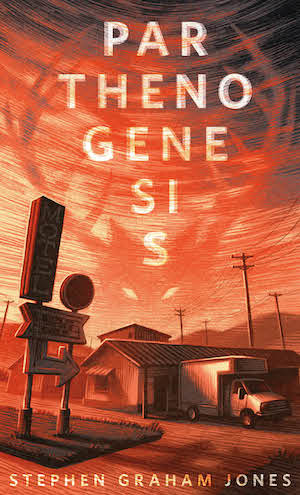Starman (1984) Directed by John Carpenter. Written by Bruce A. Evans, Raynold Gideon, Dean Riesner, and others. Starring Jeff Bridges, Karen Allen, and Charles Martin Smith.
About fifty thousand years ago, an iron meteorite over a hundred feet in diameter smashed into the Colorado Plateau, ejecting millions of tons of sedimentary rock to create a large crater. Because the impact is very young and located in a relatively low-erosion environment (even in the past, when the climate of the region was cooler and damper), the impact site, which is called Meteor Crater, is among the world’s most well-studied craters. It’s even used to train NASA astronauts to prepare for exploring impact-rich terrains.
The crater has not, as far as I am aware, ever been used as an alien rendezvous site. Probably. Maybe. They didn’t cover that in my geology classes.
Starman ends at Meteor Crater, but it doesn’t start there. It begins in space, where we see an alien entity encounter the Voyager 2 spacecraft and listen to the Golden Record, which contains messages from the people of Earth. Some of those messages are invitations, and the alien entity decides to take us up on it and heads toward Earth. Naturally, the U.S. military attempts to shoot the unidentified craft down instead of welcoming the visitor with open arms, and the alien crash-lands in Wisconsin. The U.S. government sets out to identify the vessel they shot down, while the alien sets out to explore a bit of Earth.
What the alien finds is the home of Jenny Hayden (Karen Allen), who is recently widowed and mourning her dead husband. The alien transforms from a ball of light into a copy of the husband (Jeff Bridges), which is, unsurprisingly, both frightening and unsettling to Jenny. The alien enlists Jenny’s unwilling help: He needs to get to his spaceship pick-up point in Arizona in three days. They hit the road in her ’77 Mustang, while government agents, including SETI scientist Mark Shermin (Charles Martin Smith), track them across the country.
This is the least John Carpenter movie that John Carpenter ever John Carpentered. It’s so normal. It sits right in the middle of what was mainstream in mid-’80s American sci fi: friendly visitors from outer space, ordinary humans who mean well, government agents being shady, scientists being excited, aren’t-people-quirky humor, and the theme of how humans aren’t so bad after all. It’s warm and optimistic and nobody dies. In fact, the on-screen death count is negative, because a dead deer comes back to life. It’s the exact opposite of The Thing (1982) in every conceivable way.
A lot of articles claim that Carpenter directed Starman because he needed to recover from The Thing’s dramatic commercial and critical failure. That seems to have been only part of the story; there was also an element of being in the right place at the right time. Carpenter has said that Christine (1983), the Stephen King adaptation that came between The Thing and Starman, was the film he took on when he couldn’t find any other work—and Christine did all right, really, for a movie about a haunted car. At the same time, Starman had been in development at Columbia Pictures for a long time. It had gone through a number of writers and directors, and the studio wanted somebody who would actually get the film made. Carpenter, regardless of his reputation as a director at that point, was a guy who could do that.
A movie passing from director to director is pretty standard in the industry, but the story about Starman’s screenplay is a good old-fashioned Hollywood mess. The initial script was written by Bruce A. Evans and Raynold Gideon right around the time Columbia, along with everybody else in Hollywood, was looking to capitalize on the tremendous success of Close Encounters of the Third Kind (1977). But most of the script versions and rewrites were done by Dean Riesner, with input from at least two more uncredited screenwriters. Riesner, with Carpenter’s extremely vehement support, lobbied for credit via Writers Guild arbitration, but was denied. From what I’ve been able to find, nobody involved with the filming disputes that the final script was mostly Riesner’s, even though his name shows up nowhere in any credits.
The other Hollywood story around Starman’s development is about the movie it isn’t. Because when Columbia decided to focus on developing Starman, they simultaneously opted to set aside a similar alien-focused project: a pitch called Night Skies from Steven Spielberg, who had reluctantly offered up a potential sequel to Close Encounters, mostly to prevent the studio from doing it without him. Night Skies was never made into a movie as it was initially conceived; Columbia abandoned it because they thought elements were too cutesy and childish. It was picked up by Universal, where Spielberg focused on the cutesy, childish aspects and developed the idea into E.T. the Extraterrestrial (1982). This was a bit embarrassing for Starman, which ended up looking like a too-little-too-late E.T. rip-off—a criticism that isn’t unfair, because Columbia was absolutely trying to ride the coattails of E.T.’s record-breaking success. (Because of the details of the deal when the project changed studios, Columbia apparently still made money off E.T. And because E.T. became the highest-grossing movie ever at that point, that was a lot of money.)
We’re not talking about E.T. today (we probably will at some point), but it’s impossible to talk about any ’80s sci fi about aliens coming to Earth without acknowledging that inescapable Spielberg influence. Close Encounters and E.T. were such huge, successful, genre-defining films that we can see their fingerprints everywhere. All of the rewriting and shuffling happened because the studio wanted a mainstream sci fi movie to match Close Encounters and E.T. levels of popularity. Riesner recalled being told to make Starman “different from E.T., but keep it the same.” (Apologies to all the writers out there who just did a full-body shudder as they recalled the times editors have unhelpfully told them to do exactly that.)
Most of that happened before Carpenter was attached to the project. He came on after the studio did all of its pushing and fussing. He knew the film wasn’t at all what people expected from him, but he didn’t seem to feel like it was a great creative stretch. In a 1985 interview with LA Weekly, He said, “…Starman is a love story. It’s It Happened One Night. It’s all the classic stories of star-crossed lovers, the lovers who can’t really make it together but have a bond of love… It was easy for me to tap into that, real easy. It’s a departure, because people haven’t seen something like this from me before. But now they have.”
Starman is not a great film, but it’s certainly not a terrible one either. It’s not at all to my personal taste, being a love story wrapped up in Americana that hits a series of road trip clichés on its way from Wisconsin to Arizona, but I found it to be charming and enjoyable. The special effects are pretty shaky, even by ’80s standards. There was a lot of talent behind the designs—Joe Alves, Rick Baker, Stan Winston, and make-up artist Dick Smith—but they have spoken about how they were unhappy with the production, and especially with the work done by Industrial Light & Magic (ILM), the special effects company created by George Lucas during the production of Star Wars.
I can’t really blame them for feeling that way. That alien-baby-naked man transformation scene is… regrettable. It would have been less upsetting if it sprouted spider legs and scuttled away.
What Starman really has going for it is its cast. Lead actors Karen Allen and Jeff Bridges are absolutely wonderful in their roles, and their presence and chemistry are impeccable. I don’t know if anybody made it through the ’80s without being a little bit in love with Karen Allen (Raiders of the Lost Ark came out in 1981), and the reasons for that are all on display here. Her portrayal of quiet, lonely grief is understated and gentle, as is the way she slowly opens up and grows to care for the alien. The movie wouldn’t work at all if we didn’t believe Jenny’s unease and curiosity, her patience and amusement, and ultimately her shift from yearning for the past to being able to imagine a future.
Starman was one of many steps on Jeff Bridges’ climb toward unshakable stardom, with equally good reason. He was nominated for an Academy Award for Best Actor for his portrayal of the alien. Bridges put a lot of thought into his character; he watched his young daughters to get ideas about how somebody completely new to this world might take it all in, and he worked with a dancer friend to develop the alien’s peculiar way of moving. The result is sometimes awkward, sometimes hesitant, sometimes humorous, but always very careful and deliberate.
I’ve said this before and I’ll say it again, but movies about aliens coming to Earth are never really about aliens. They are about us, about humans as individuals and humanity as a whole. In this way, I think, Starman is a thematic sibling to The Brother From Another Planet, which also came out in 1984 but was a low-budget arthouse flick rather than a major Hollywood movie. Both use gentle fish-out-of-water humor to reflect human behavior and quirks back at us. Those reflections come from both the human characters and the alien characters. Joe Morton’s character in The Brother From Another Planet is seeking safety and community while fleeing from violence. Bridges’ character in Starman is looking for something else: he’s an explorer. And, as Charles Martin Smith’s character points out, the alien has come to Earth because he was invited.
I’m glad the movie clarifies that, because I think it’s important. The alien has come to Earth for no reason other than to have a look around. He doesn’t want anything from Earth or its people. No resources, no sanctuary, nothing like that. Nor has he come to impart a lesson to humanity. He’s a mapmaker, driven by curiosity, and all he takes away are observations. He only wants to meet and learn a bit about the species that sent the Golden Record into space.
I enjoy this characterization of this alien visitor as friendly, inquisitive, and open-minded, and I think it works especially well as the framework for a love story. This is a story about a connection between two people—and about a connection between two species. There are a lot of first contact stories with romantic subplots, but sci fi doesn’t often characterize alien first contact itself in primarily romantic terms. In Starman, the characters begin by knowing nothing about each other, but they ask questions, they observe, they learn, and they grow fond of the ways in which they are both similar and different, and when they part, they do it fondly, knowing they are both better for their time together. It’s warm, sweet, and completely free of cynicism.
I think that’s why I find the movie charming, even though it’s not something I feel a very strong attachment to. I might prefer stories with a lot more tension and danger and heads sprouting spider legs, but sci fi has room for both those films and their complete opposites. When I think about space exploration, and the inherent hopefulness of sending messages out into the universe without knowing if anybody is listening, I appreciate a story that offers an alternative to always expecting the very worst.
What do you think of Starman? Where does it rank in the John Carpenter catalogue for you? Does anybody remember the short-lived TV show based on the movie that came out a few years later? Oh, and I’m curious: Aside from Star Trek: The Motion Picture (1979), are there other sci fi movies that use “aliens find an Earth space probe” as a plotline?
Next week: Obey. Consume. Conform. Surrender. They Live. Watch: Peacock, Apple, Microsoft, Amazon.










